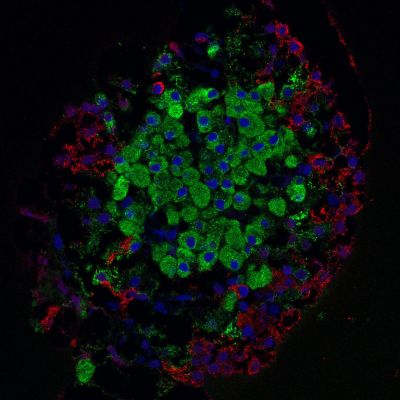Bridging the gap in molecular dynamics

Pancreaticislet
By Masur (Own work) [GFDL (http://www.gnu.org/copyleft/fdl.html), CC-BY-SA-3.0 (http://creativecommons.org/licenses/by-sa/3.0/) or CC BY 2.5 (http://creativecommons.org/licenses/by/2.5)], via Wikimedia Commons
An EU-funded project is blasting transition-metal molecules and others with extreme ultraviolet (XUV) radiation to probe their dynamics. The study has important implications for excited-state processes such as DNA photoprotection, light harvesting and atmospheric chemistry.
Interaction between electrons and between electrons and nuclei is
described by a many-particle Schrodinger equation that is generally too
complex to be solved. The Born–Oppenheimer approximation (BOA) — which
simplifies electron–nuclear interactions — breaks down when two
potential energy surfaces cross each other in a conical intersection
(CI). Locating and characterising these CIs are essential to
understanding a wide range of chemical reactions.
The EU-funded project XBEBOA is studying molecular dynamics in
certain chemical elements and compounds that cannot be described by the
BOA framework. XBEBOA is advancing state-of-the-art ultrafast pump–probe
spectroscopy by implementing novel time-resolved setups that use XUV
and soft X-ray radiation to probe ultrafast molecular dynamics.
To date, main project achievements include construction and
commission of a XUV transient grating setup and its application to the
photo-induced phase transition in vanadium dioxide. The setup is
flexible and is based on a commercial laser system. XUV light is
generated by high-harmonic generation in noble gases and used for
time-resolved spectroscopy. An in-line monitoring tool has been
developed that measures the XUV flux on a shot-by-shot basis and can be
used in data acquisition to correct fluctuations.
First results on vanadium dioxide samples show that the XUV light in
vicinity of the M edge — excited electrons — is clearly distinct from
off-resonance probing at lower photon energies.
Furthermore, a time-resolved photoelectron spectroscopy (PES) setup
has been installed and commissioned. This technique has been used to
study the gas-phase molecular samples after excitation with XUV light,
overcoming limitations of state-of-the-art PES. The results obtained
from perylene have shown important discrepancies between XUV and
multiphoton infrared modes.
Understanding the molecular dynamics in CIs should further reveal
the most fundamental processes of our very existence and improve
strategies in clean energy research. The setup description and project
results have been published in peer-reviewed journals, and at least
other six scientific papers are on the way.
published: 2015-03-05

